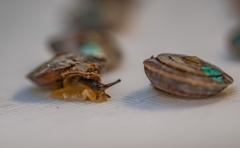The fish, Branchiostegus sanae, showcases cheek markings reminiscent of the film's warrior princess, San, highlighting the intersection of marine biology and popular culture.
Warrior Princess Inspiration: New Fish Species Named after San from Studio Ghibli

Warrior Princess Inspiration: New Fish Species Named after San from Studio Ghibli
A newly discovered deepwater fish species draws homage from the iconic anime film Princess Mononoke.
A deepwater fish recently identified by Chinese researchers has garnered attention for its unique facial markings, which resemble the iconic warrior princess San from the celebrated Studio Ghibli film Princess Mononoke. Dubbed Branchiostegus sanae, this new species adds a pop culture flair to the field of marine biology.
Researchers at the South China Sea Institute of Oceanology, alongside other academic institutions, made this discovery after noting the fish's distinctive striped cheeks, reminiscent of San's fierce appearance. In Hayao Miyazaki's 1997 animated film, San, the young woman raised by wolves, becomes a symbol of nature's resilience and the struggles between humanity and the environment.
The film was critically acclaimed in Japan, achieving box office success with over 19 billion yen (approximately £100.4 million). The character of San represents a deep connection to the forest, along with an underlying message of the necessity for humans to coexist harmoniously with nature—a principle that the researchers aimed to honor through this naming.
Branchiostegus sanae belongs to the family of deepwater tilefish, known for inhabiting vast ocean depths, with some reaching as far as 600 meters below the surface. Using genetic analysis, the team confirmed its new species status, marking an important find in a family that has seen minimal diversity.
"This is a fortunate discovery," stated Haochen Huang, the lead author of the study. "In the past 34 years, only three new species in the Branchiostegus genus have been identified, making our find exceptionally special."
While deepwater tilefish are commonly sold in seafood markets across East and Southeast Asia, the awareness of their diversity is lacking, as only 31 species in the family Branchiostegidae have been documented. The specimens of Branchiostegus sanae have been preserved in marine biological collections, which will facilitate ongoing research into this vibrant new addition to the ocean's ecosystem.
Researchers at the South China Sea Institute of Oceanology, alongside other academic institutions, made this discovery after noting the fish's distinctive striped cheeks, reminiscent of San's fierce appearance. In Hayao Miyazaki's 1997 animated film, San, the young woman raised by wolves, becomes a symbol of nature's resilience and the struggles between humanity and the environment.
The film was critically acclaimed in Japan, achieving box office success with over 19 billion yen (approximately £100.4 million). The character of San represents a deep connection to the forest, along with an underlying message of the necessity for humans to coexist harmoniously with nature—a principle that the researchers aimed to honor through this naming.
Branchiostegus sanae belongs to the family of deepwater tilefish, known for inhabiting vast ocean depths, with some reaching as far as 600 meters below the surface. Using genetic analysis, the team confirmed its new species status, marking an important find in a family that has seen minimal diversity.
"This is a fortunate discovery," stated Haochen Huang, the lead author of the study. "In the past 34 years, only three new species in the Branchiostegus genus have been identified, making our find exceptionally special."
While deepwater tilefish are commonly sold in seafood markets across East and Southeast Asia, the awareness of their diversity is lacking, as only 31 species in the family Branchiostegidae have been documented. The specimens of Branchiostegus sanae have been preserved in marine biological collections, which will facilitate ongoing research into this vibrant new addition to the ocean's ecosystem.



















